m (fixing dead links) |
m (fixing dead links) |
||
| Line 53: | Line 53: | ||
===Fork trucks=== |
===Fork trucks=== |
||
| − | A '''HICE forklift''' or '''HICE lift truck''' is a [[hydrogen]] fueled, [[internal combustion engine]] powered industrial [[forklift truck]] used for lifting and [[transport]]ing materials. The first production HICE forklift truck based on the Linde X39 Diesel was presented at an exposition in [[Hannover]] on May 27, 2008. It used a 2.0 litre, 43 kW diesel internal combustion engine converted to use hydrogen as a fuel with the use of a compressor and [[fuel injection#Direct injection|direct injection]].<ref>{{cite web|url=http://www.accessmylibrary.com/coms2/summary_0286-35668015_ITM |title=Hydrogen engines get a lift |publisher=Accessmylibrary.com |date=2008-10-01 |accessdate=2010-12-12}}</ref><ref name="HyICE">[https://www.hfpeurope.org/uploads/700/836/2005_HFP_Brussels_HyICE.pdf HyICE]</ref> The [[hydrogen tank]] is filled with 26 liters of hydrogen at 350 bar pressure. |
+ | A '''HICE forklift''' or '''HICE lift truck''' is a [[hydrogen]] fueled, [[internal combustion engine]] powered industrial [[forklift truck]] used for lifting and [[transport]]ing materials. The first production HICE forklift truck based on the Linde X39 Diesel was presented at an exposition in [[Hannover]] on May 27, 2008. It used a 2.0 litre, 43 kW diesel internal combustion engine converted to use hydrogen as a fuel with the use of a compressor and [[fuel injection#Direct injection|direct injection]].<ref>{{cite web|url=http://www.accessmylibrary.com/coms2/summary_0286-35668015_ITM |title=Hydrogen engines get a lift |publisher=Accessmylibrary.com |date=2008-10-01 |accessdate=2010-12-12|archiveurl=http://web.archive.org/web/20131202222631/http://www.accessmylibrary.com/coms2/summary_0286-35668015_ITM|archivedate=2013-12-02}}</ref><ref name="HyICE">[https://www.hfpeurope.org/uploads/700/836/2005_HFP_Brussels_HyICE.pdf HyICE]</ref> The [[hydrogen tank]] is filled with 26 liters of hydrogen at 350 bar pressure. |
===Rockets=== |
===Rockets=== |
||
Revision as of 20:56, 24 August 2014
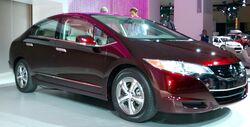
Honda FCX Clarity, a hydrogen fuel cell demonstration vehicle introduced in 2008
A hydrogen vehicle is a vehicle that uses hydrogen as its onboard fuel for motive power. Hydrogen vehicles include hydrogen fueled space rockets, as well as automobiles and other transportation vehicles. The power plants of such vehicles convert the chemical energy of hydrogen to mechanical energy either by burning hydrogen in an internal combustion engine, or by reacting hydrogen with oxygen in a fuel cell to run electric motors. Widespread use of hydrogen for fueling transportation is a key element of a proposed hydrogen economy.
Hydrogen fuel does not occur naturally on Earth and thus is not an energy source, but is an energy carrier. Currently it is most frequently made from methane or other fossil fuels. However, it can be produced from a wide range of sources (such as wind, solar, or nuclear) that are intermittent, too diffuse or too cumbersome to directly propel vehicles. Integrated wind-to-hydrogen plants, using electrolysis of water, are exploring technologies to deliver costs low enough, and quantities great enough, to compete with traditional energy sources.[1]
Many companies are working to develop technologies that might efficiently exploit the potential of hydrogen energy for mobile uses. The attraction of using hydrogen as an energy currency is that, if hydrogen is prepared without using fossil fuel inputs, vehicle propulsion would not contribute to carbon dioxide emissions. The drawbacks of hydrogen use are low energy content per unit volume, high tankage weights, very high storage vessel pressures, the storage, transportation and filling of gaseous or liquid hydrogen in vehicles, the large investment in infrastructure that would be required to fuel vehicles, and the inefficiency of production processes.
Vehicles
Buses, trains, PHB bicycles, canal boats, cargo bikes, golf carts, motorcycles, wheelchairs, ships, airplanes, submarines, and rockets can already run on hydrogen, in various forms. NASA used hydrogen to launch the Space Shuttles into space. A working toy model car runs on solar power, using a regenerative fuel cell to store energy in the form of hydrogen and oxygen gas. It can then convert the fuel back into water to release the solar energy.[2]
The current land speed record for a hydrogen-powered vehicle is 286.476 mph (461.038 km/h) set by Ohio State University's Buckeye Bullet 2, which achieved a "flying-mile" speed of 280.007 mph (450.628 km/h) at the Bonneville Salt Flats in August 2008. For production-style vehicles, the current record for a hydrogen-powered vehicle is 333.38 km/h (207.2 mph) set by a prototype Ford Fusion Hydrogen 999 Fuel Cell Race Car at Bonneville Salt Flats in Wendover, Utah in August 2007. It was accompanied by a large compressed oxygen tank to increase power. Honda has also created a concept called the FC Sport that it hopes will challenge that record.[3]
Automobiles
- Main article: List of fuel cell vehicles
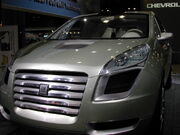
Sequel, a fuel cell-powered vehicle from General Motors
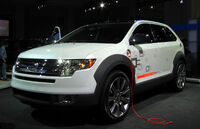
Ford Edge hydrogen-electric plug-in hybrid concept
Many companies are currently researching the feasibility of building hydrogen cars, and some automobile manufacturers have begun developing hydrogen cars (see list of fuel cell vehicles). Funding has come from both private and government sources. However, the Ford Motor Company has dropped its plans to develop hydrogen cars, stating that "The next major step in Ford’s plan is to increase over time the volume of electrified vehicles".[4] Similarly, French Renault-Nissan announced in 2009 that it is cancelling its hydrogen car R&D efforts.[5] As of October 2009, General Motors CEO Fritz Henderson noted that GM had reduced its hydrogen program because the cost of building hydrogen cars was too high. "It's still a ways away from commercialization", he said. The "Volt will likely cost around $40,000 while a hydrogen vehicle would cost around $400,000.[6] Most hydrogen cars are currently only available as demonstration models for lease in limited numbers and are not yet ready for general public use. The estimated number of hydrogen-powered cars in the United States was 200 as of October 2009, mostly in California.[7]
Honda introduced its first fuel cell vehicle in 1999 called the FCX and has since then introduced the second generation FCX Clarity. In 2007 at the Greater Los Angeles Auto Show, Honda unveiled the first production model of the FCX Clarity. Limited marketing of the FCX Clarity began in June 2008 in the United States, and it was introduced in Japan in November 2008.[8] The FCX Clarity is available in the U.S. only in Los Angeles Area, where 16 hydrogen filling stations are available, and as of July 2009, ten drivers had leased the Clarity for US$600 a month.[9] Honda stated that it could start mass producing vehicles based on the FCX concept by the year 2020[9] and reaffirmed, in 2009, that it continues to put resources into hydrogen fuel cell development, which it saw as "a better long term bet than batteries and plug-in vehicles".[10] In December 2010, however, it introduced a BEV version of the Honda Fit, using elements of its hydrogen engine design, stating that the "industry trend seems to be focused on the battery electric vehicle".[11]
In 2011, Hyundai revealed its Blue2 ("Blue Square") fuel cell electric vehicle (FCEV), and stated that it plans to have FCEVs available for sale by 2014.[12] In early 2009, Daimler announced plans to begin its FC vehicle production in 2009 with the aim of 100,000 vehicles in 2012–2013.[13][14] In 2009, Nissan started testing a new FC vehicle in Japan.[15] In September 2009, Daimler, Ford, General Motors, Honda, Hyundai, Kia, Renault, Nissan and Toyota issued a joint statement about their undertaking to further develop and launch fuel-cell electric vehicles as early as 2015.[16]
In February 2010 Lotus Cars announced that it was developing a fleet of hydrogen taxis for use in London. London's deputy mayor, Kit Malthouse, said he hoped six filling stations would be available and that around 20 to 50 taxis would be in operation by the time of the 2012 Olympic Games, as well as 150 hydrogen-powered buses.[17]
In March 2010, General Motors said it had not abandoned fuel-cell technology and is still targeted to introduce hydrogen vehicles to retail customers by 2015. Charles Freese, GM’s executive director of global powertrain engineering, stated that the company believes that both fuel-cell vehicles and battery electric vehicles are needed for reduction of greenhouse gases and reliance on oil, and the U.S. should follow Germany and Japan in adopting a more uniform strategy on advanced technology options. Both countries have announced plans to open 1,000 hydrogen fuel stations.[18]
Buses
- Main article: fuel cell bus
Fuel cell buses (as opposed to hydrogen fueled buses) are being trialed by several manufacturers in different locations. The Fuel Cell Bus Club is a global fuel cell bus testing collaboration.
Hydrogen was first stored in roof mounted tanks, although models are now incorporating onboard tanks. Some double deck models use between floor tanks.
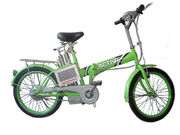
Hydrogen bicycle
Bicycles
- Main article: PHB (bicycle)
Pearl Hydrogen Power Sources of Shanghai, China, unveiled a hydrogen bicycle at the 9th China International Exhibition on Gas Technology, Equipment and Applications in 2007.
Motorcycles and scooters
ENV develops electric motorcycles powered by a hydrogen fuel cell, including the Crosscage and Biplane. Other manufacturers such as Vectrix are working on hydrogen scooters.[19] Finally, hydrogen fuel cell-electric hybrid scooters are being made such as the Suzuki Burgman Fuel cell scooter[20] and the FHybrid.[21]
Quads and tractors
Autostudi S.r.l's H-Due[22] is a hydrogen-powered quad, capable of transporting 1-3 passengers. A concept for a hydrogen powered tractor has been proposed.[23]
Airplanes

The Boeing Fuel Cell Demonstrator powered by a hydrogen fuel cell
Companies such as Boeing, Lange Aviation, and the German Aerospace Center pursue hydrogen as fuel for manned and unmanned airplanes. In February 2008 Boeing tested a manned flight of a small aircraft powered by a hydrogen fuel cell. Unmanned hydrogen planes have also been tested.[24] For large passenger airplanes however, The Times reported that "Boeing said that hydrogen fuel cells were unlikely to power the engines of large passenger jet airplanes but could be used as backup or auxiliary power units onboard."[25]
In July 2010 Boeing unveiled its hydrogen powered Phantom Eye UAV, powered by two Ford internal combustion engines that have been converted to run on hydrogen.[26]
In Europe, the Reaction Engines A2 has been proposed to use the thermodynamic properties of liquid hydrogen to achieve very high speed, long distance (antipodal) flight by burning it in a precooled jet engine.
Fork trucks
A HICE forklift or HICE lift truck is a hydrogen fueled, internal combustion engine powered industrial forklift truck used for lifting and transporting materials. The first production HICE forklift truck based on the Linde X39 Diesel was presented at an exposition in Hannover on May 27, 2008. It used a 2.0 litre, 43 kW diesel internal combustion engine converted to use hydrogen as a fuel with the use of a compressor and direct injection.[27][28] The hydrogen tank is filled with 26 liters of hydrogen at 350 bar pressure.
Rockets
Many large rockets use liquid hydrogen as fuel, with liquid oxygen as an oxidizer. The main advantage of hydrogen rocket fuel is the high effective exhaust velocity compared to kerosene/LOX or UDMH/NTO engines. According to the 'Tsiolkovsky' rocket equation, a rocket with higher exhaust velocity needs less propellant mass to achieve a given change of speed. Before combustion, the hydrogen runs through cooling pipes around the exhaust nozzle to protect the nozzle from damage by the hot exhaust gases.[29]
The disadvantages of LH2/LOX engines are the low density and low temperature of liquid hydrogen, which means bigger and insulated and thus heavier fuel tanks are needed. This increases the rocket's structural mass and decreases its efficiency somewhat. Another disadvantage is the poor storability of LH2/LOX-powered rockets: Due to the constant hydrogen boil-off, the rocket can only be fueled shortly before launch, which makes cryogenic engines unsuitable for ICBMs and other rocket applications with the need for short launch preparations.
Liquid hydrogen and oxygen were also used in the Space Shuttle to run the fuel cells that power the electrical systems.[30] The byproduct of the fuel cell is water, which is used for drinking and other applications that require water in space.
Internal combustion vehicle
- Main article: Hydrogen internal combustion engine vehicle
Hydrogen internal combustion engine cars are different from hydrogen fuel cell cars. The hydrogen internal combustion car is a slightly modified version of the traditional gasoline internal combustion engine car. These hydrogen engines burn fuel in the same manner that gasoline engines do.
Francois Isaac de Rivaz designed in 1807 the first hydrogen-fueled internal combustion engine.[31] Paul Dieges patented in 1970 a modification to internal combustion engines which allowed a gasoline-powered engine to run on hydrogen US 3844262.
Mazda has developed Wankel engines burning hydrogen. The advantage of using ICE (internal combustion engine) like Wankel and piston engines is the cost of retooling for production is much lower. Existing-technology ICE can still be applied for solving those problems where fuel cells are not a viable solution insofar, for example in cold-weather applications.
HICE forklift trucks have been demonstrated[32] based on converted diesel internal combustion engines with direct injection.[28]
Fuel cell
While fuel cells themselves are potentially highly energy efficient, and working prototypes were made by Francis Thomas Bacon in 1959[33] and Roger E. Billings in the 1960s, at least four technical obstacles and other political considerations exist regarding the development and use of a fuel cell-powered hydrogen car: the cost, reliability and durability of the fuel cells; storage of hydrogen for use in fuel cells; production of hydrogen; and delivery of hydrogen to vehicles.[34]
Fuel cell cost
Currently, hydrogen fuel cells are relatively expensive to produce and some are fragile. As of October 2009, Fortune magazine estimated the cost of producing the Honda Clarity at $300,000 per car.[35] Also, many designs require rare substances such as platinum as a catalyst in order to work properly. Occasionally, a catalyst can become contaminated by impurities in the hydrogen supply, rendering the fuel cell inoperable. In 2010, research and design advances developed a new nickel-tin nanometal catalyst which lowers the cost of cells.[36]
Fuel cells are generally priced in USD/kW. The U.S. Department of Energy estimated that the cost of a fuel cell for an automobile in 2002 was approximately $275/kw, which translated into each vehicle costing more than 1 million dollars. However, by 2010, the Department of Energy estimated that the cost had fallen 80% and that such fuel cells could be manufactured for $51/kW, assuming high-volume manufacturing cost savings.[37] Ballard Power Systems also published similar data. Their 2005 figure was $73 USD/kW (based on high volume manufacturing estimates), which they said was on track to achieve the U.S. Department of Energy's 2012 goal of $30 USD/kW. This would achieve closer parity with internal combustion engines for automotive applications, allowing a 100 kW fuel cell to be produced for $3000. 100 kW is about 134 hp.[38]
Freezing conditions
Temperatures below freezing are a concern with fuel cells operations. Operational fuel cells have an internal vaporous water environment that could solidify if the fuel cell and contents are not kept above 0° Celsius (32°F). Most fuel cell designs are not as yet robust enough to survive in below-freezing environments. Frozen solid, especially before start up, they would not be able to begin working. Once running though, heat is a byproduct of the fuel cell process, which would keep the fuel cell at an adequate operational temperature to function correctly. This makes startup of the fuel cell a concern in cold weather operation. Places such as Alaska where temperatures can reach −40 °C (−40 °F) at startup would not be able to use early model fuel cells. Ballard announced in 2006 that it had already hit the U.S. DoE's 2010 target for cold weather starting which was 50% power achieved in 30 seconds at -20 °C.[39]
Fuel cells have startup and long term reliability problems. Early gasoline engines had the characteristic of higher heat dissipation once running, whereas fuels cells emit less heat, making the warm up process somewhat slower.[40]
Service life
Although service life is coupled to cost, fuel cells have to be compared to existing machines with a service life in excess of 5000 hours[41] for stationary and light-duty. Marine PEM fuel cells reached the target in 2004.[42] Current service life is 7,300 hours under cycling conditions.[43] Research is going on especially for heavy duty like in the bus trials which are targeted up to a service life of 30,000 hours.
Hydrogen
Hydrogen does not come as a pre-existing source of energy like fossil fuels, but is first produced and then stored as a carrier, much like a battery. Hydrogen for vehicle uses needs to be produced using either renewable or non-renewable energy sources. A suggested benefit of large-scale deployment of hydrogen vehicles is that it could lead to decreased emissions of greenhouse gases and ozone precursors.[44]
According to the United States Department of Energy "Producing hydrogen from natural gas does result in some greenhouse gas emissions. When compared to ICE vehicles using gasoline, however, fuel cell vehicles using hydrogen produced from natural gas reduce greenhouse gas emissions by 60%.[45] While methods of hydrogen production that do not use fossil fuel would be more sustainable,[46] currently renewable energy represents only a small percentage of energy generated, and power produced from renewable sources can be used in electric vehicles and for non-vehicle applications.[47]
The challenges facing the use of hydrogen in vehicles include production, storage, transport and distribution. Because of all these challenges, the well-to-wheel efficiency for hydrogen is less than 25%.[48][49][50]
Production
The molecular hydrogen needed as an on-board fuel for hydrogen vehicles can be obtained through many thermochemical methods utilizing natural gas, coal (by a process known as coal gasification), liquefied petroleum gas, biomass (biomass gasification), by a process called thermolysis, or as a microbial waste product called biohydrogen or Biological hydrogen production. 95% of hydrogen is produced using natural gas,[51] and 85% of hydrogen produced is used to remove sulfur from gasoline. Hydrogen can also be produced from water by electrolysis or by chemical reduction using chemical hydrides or aluminum.[52] Current technologies for manufacturing hydrogen use energy in various forms, totaling between 25 and 50 percent of the higher heating value of the hydrogen fuel, used to produce, compress or liquefy, and transmit the hydrogen by pipeline or truck.[53]
Environmental consequences of the production of hydrogen from fossil energy resources include the emission of greenhouse gases, a consequence that would also result from the on-board reforming of methanol into hydrogen.[48] Studies comparing the environmental consequences of hydrogen production and use in fuel-cell vehicles to the refining of petroleum and combustion in conventional automobile engines find a net reduction of ozone and greenhouse gases in favor of hydrogen.[44] Hydrogen production using renewable energy resources would not create such emissions or, in the case of biomass, would create near-zero net emissions assuming new biomass is grown in place of that converted to hydrogen. However the same land could be used to create Biodiesel, usable with (at most) minor alterations to existing well developed and relatively efficient diesel engines. In either case, the scale of renewable energy production today is small and would need to be greatly expanded to be used in producing hydrogen for a significant part of transportation needs.[54] As of December 2008, less than 3 percent of U.S. electricity was produced from renewable sources, not including dams.[55] In a few countries, renewable sources are being used more widely to produce energy and hydrogen. For example, Iceland is using geothermal power to produce hydrogen,[56] and Denmark is using wind.[57]
Storage
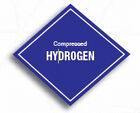
Compressed hydrogen storage mark
Hydrogen has a very low volumetric energy density at ambient conditions, equal to about one-third that of methane. Even when the fuel is stored as liquid hydrogen in a cryogenic tank or in a compressed hydrogen storage tank, the volumetric energy density (megajoules per liter) is small relative to that of gasoline. Hydrogen has a three times higher specific energy by mass compared to gasoline (143 MJ/kg versus 46.9 MJ/kg). Some research has been done into using special crystalline materials to store hydrogen at greater densities and at lower pressures. A recent study by Dutch researcher Robin Gremaud has shown that metal hydride hydrogen tanks are actually 40 to 60-percent lighter than an equivalent energy battery pack on an electric vehicle permitting greater range for H2 cars.[58] In 2011, scientists at Los Alamos National Laboratory and University of Alabama, working with the U.S. Department of Energy, found a new single-stage method for recharging ammonia borane, a hydrogen storage compound.[59][60]
Infrastructure
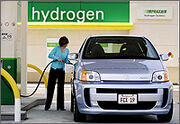
Hydrogen car fueling
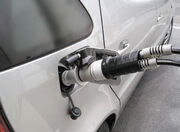
Hydrogen fueling
The hydrogen infrastructure consists mainly of industrial hydrogen pipeline transport and hydrogen-equipped filling stations like those found on a hydrogen highway. Hydrogen stations which are not situated near a hydrogen pipeline can obtain supply via hydrogen tanks, compressed hydrogen tube trailers, liquid hydrogen tank trucks or dedicated onsite production.
Hydrogen use would require the alteration of industry and transport on a scale never seen before in history. For example, according to GM, 70% of the U.S. population lives near a hydrogen-generating facility but has little access to hydrogen, despite its wide availability for commercial use.[61] The distribution of hydrogen fuel for vehicles throughout the U.S. would require new hydrogen stations costing, by some estimates, 20 billion dollars.[62] and 4.6 billion in the EU.[63] Other estimates place the cost as high as half trillion dollars in the United States alone.[64]
The California Hydrogen Highway is an initiative to build a series of hydrogen refueling stations along that state. These stations are used to refuel hydrogen vehicles such as fuel cell vehicles and hydrogen combustion vehicles. As of March 2011, the California Fuel Cell Partnership showed 20 stations in operation, with eight more planned. These are located mostly in and around Los Angeles, with a few in the Bay area[65][66] South Carolina also has a hydrogen freeway project, and the first two hydrogen fueling stations opened in 2009 in Aiken and Columbia, South Carolina. According to the South Carolina Hydrogen & Fuel Cell Alliance, the Columbia station has a current capacity of 120 kg a day, with future plans to develop on-site hydrogen production from electrolysis and reformation. The Aiken station has a current capacity of 80 kg. There are several funding projects for Hydrogen fuel cell research and infrastructure in South Carolina. The University of South Carolina, a founding member of the South Carolina Hydrogen & Fuel Cell Alliance, received 12.5 million dollars from the Department of Energy for its Future Fuels Program.[67]
Codes and standards
Hydrogen codes and standards, as well as codes and technical standards for hydrogen safety and the storage of hydrogen, have been identified as an institutional barrier to deploying hydrogen technologies and developing a hydrogen economy. To enable the commercialization of hydrogen in consumer products, new codes and standards must be developed and adopted by federal, state and local governments.[68]
Criticism
Critics claim the time frame for overcoming the technical and economic challenges to implementing wide-scale use of hydrogen vehicles is likely to last for at least several decades, and hydrogen vehicles may never become broadly available.[47][69] They claim that the focus on the use of the hydrogen car is a dangerous detour from more readily available solutions to reducing the use of fossil fuels in vehicles.[70] In May 2008, Wired News reported that "experts say it will be 40 years or more before hydrogen has any meaningful impact on gasoline consumption or global warming, and we can't afford to wait that long. In the meantime, fuel cells are diverting resources from more immediate solutions."[71]
K. G. Duleep speculates that "a strong case exists for continuing fuel-efficiency improvements from conventional technology at relatively low cost."[72] Critiques of hydrogen vehicles are presented in the 2006 documentary, Who Killed the Electric Car?. According to former U.S. Department of Energy official Joseph Romm, "A hydrogen car is one of the least efficient, most expensive ways to reduce greenhouse gases." Asked when hydrogen cars will be broadly available, Romm replied: "Not in our lifetime, and very possibly never."[72] The Los Angeles Times wrote, in February 2009, "Hydrogen fuel-cell technology won't work in cars. ... Any way you look at it, hydrogen is a lousy way to move cars."[73] A 2007 article in Technology Review stated, "In the context of the overall energy economy, a car like the BMW Hydrogen 7 would probably produce far more carbon dioxide emissions than gasoline-powered cars available today. And changing this calculation would take multiple breakthroughs – which study after study has predicted will take decades, if they arrive at all. In fact, the Hydrogen 7 and its hydrogen-fuel-cell cousins are, in many ways, simply flashy distractions produced by automakers who should be taking stronger immediate action to reduce the greenhouse-gas emissions of their cars."[47][74]
The Wall Street Journal reported in 2008 that "Top executives from General Motors Corp. and Toyota Motor Corp. Tuesday expressed doubts about the viability of hydrogen fuel cells for mass-market production in the near term and suggested their companies are now betting that electric cars will prove to be a better way to reduce fuel consumption and cut tailpipe emissions on a large scale."[6][75] The Economist magazine, in September 2008, quoted Robert Zubrin, the author of Energy Victory, as saying: "Hydrogen is 'just about the worst possible vehicle fuel'".[76] The magazine noted the withdrawal of California from earlier goals: "In March [2008] the California Air Resources Board, an agency of California's state government and a bellwether for state governments across America, changed its requirement for the number of zero-emission vehicles (ZEVs) to be built and sold in California between 2012 and 2014. The revised mandate allows manufacturers to comply with the rules by building more battery-electric cars instead of fuel-cell vehicles."[76] The magazine also noted that most hydrogen is produced through steam reformation, which creates at least as much emission of carbon per mile as some of today's gasoline cars. On the other hand, if the hydrogen could be produced using renewable energy, "it would surely be easier simply to use this energy to charge the batteries of all-electric or plug-in hybrid vehicles."[76]
The Washington Post asked in November 2009, "But why would you want to store energy in the form of hydrogen and then use that hydrogen to produce electricity for a motor, when electrical energy is already waiting to be sucked out of sockets all over America and stored in auto batteries"? The paper concluded that commercializing hydrogen cars is "stupendously difficult and probably pointless. That's why, for the foreseeable future, the hydrogen car will remain a tailpipe dream".[51] A December 2009 study at UC Davis, published in the Journal of Power Sources, found that, over their lifetimes, hydrogen vehicles will emit more carbon than gasoline vehicles.[77]
In 2009 the U.S. Secretary of Energy, Stephen Chu, stated that fuel cell hydrogen vehicles "will not be practical over the next 10 to 20 years". He cited difficulties in the development of the required infrastructure to distribute hydrogen as a justification for cutting research funds.[78] The National Hydrogen Association and other hydrogen groups criticized the decision.[79] Secretary Chu told MIT's Technology Review that he is skeptical about hydrogen's use in transportation because "the way we get hydrogen primarily is from reforming [natural] gas. ... You're giving away some of the energy content of natural gas. ... So that's one problem. ... [For] transportation, we don't have a good storage mechanism yet. ... The fuel cells aren't there yet, and the distribution infrastructure isn't there yet. ... In order to get significant deployment, you need four significant technological breakthroughs. ... If you need four miracles, that's unlikely: saints only need three miracles".[34] Congress reversed the funding cuts in its appropriations bill for 2010,[7] but the Department of Energy plans to decrease funding for Fuel Cell Vehicle development in its 2012 budget.[80]
In July 2011, the Chairman and CEO of General Motors, Daniel Akerson, stated that while the cost of hydrogen fuel cell cars is decreasing: "The car is still too expensive and probably won't be practical until the 2020-plus period, I don't know."[69][81]
Comparison with other types of alternative fuel vehicle
Hydrogen vehicles are one of a number of proposed alternatives to the modern fossil fuel powered vehicle infrastructure.
Plug-in hybrids
Plug-in hybrid electric vehicles, or PHEVs, are hybrid vehicles that can be plugged into the electric grid and contain an electric motor and also an ICE or other engine. The Chevrolet Volt, the first commercially-manufactured PHEV, became commercially available in some U.S. states in 2010 and in more locations in 2011. The PHEV concept augments standard hybrid electric vehicles with the ability to recharge their batteries from an external source while parked, enabling increased use of the vehicle's electric motors while reducing their reliance on internal combustion engines. The infrastructure required to charge PHEVs is already in place,[82] and transmission of power from grid to car is about 93% efficient.[83] This, however, is not the only energy loss in transferring power from grid to wheels. AC/DC conversion must take place from the grids AC supply to the PHEV's DC. This is roughly 98% efficient.[84] The battery then must be charged. As of 2007, the Lithium iron phosphate battery was between 80-90% efficient in charging/discharging.[85] The battery needs to be cooled; the GM Volt's battery has 4 coolers and two radiators.[86] As of 2009, "the total well-to-wheels efficiency with which a hydrogen fuel cell vehicle might utilize renewable electricity is roughly 20% (although that number could rise to 25% or a little higher with the kind of multiple technology breakthroughs required to enable a hydrogen economy). The well-to-wheels efficiency of charging an onboard battery and then discharging it to run an electric motor in a PHEV or EV, however, is 80% (and could be higher in the future)—four times more efficient than current hydrogen fuel cell vehicle pathways."[50] A 2006 article in Scientific American argued that PHEVs, rather than hydrogen vehicles, would become standard in the automobile industry.[87][88] A December 2009 study at UC Davis found that, over their lifetimes, PHEVs will emit less carbon than current vehicles, while hydrogen cars will emit more carbon than gasoline vehicles.[77]
Natural gas
ICE-based CNG or LNG vehicles (Natural gas vehicles or NGVs) use Natural gas or Biogas as a fuel source. Natural gas has a higher energy density than hydrogen gas. Natural gas powered vehicles have a lower carbon dioxide footprint than ICE vehicles. When using Biogas, NGVs become carbon neutral vehicles that run on animal waste.[89] CNG vehicles have been available for several years, and there is sufficient infrastructure to provide both commercial and home refueling stations. In 2008, the ACEEE rated the Honda Civic GX, which uses compressed natural gas, as the greenest vehicle available.[90][91][92]
Battery electric vehicles
A 2008 Technology Review article stated, "Electric cars—and plug-in hybrid cars—have an enormous advantage over hydrogen fuel-cell vehicles in utilizing low-carbon electricity. That is because of the inherent inefficiency of the entire hydrogen fueling process, from generating the hydrogen with that electricity to transporting this diffuse gas long distances, getting the hydrogen in the car, and then running it through a fuel cell—all for the purpose of converting the hydrogen back into electricity to drive the same exact electric motor you'll find in an electric car."[93] Thermodynamically, each additional step in the conversion process decreases the overall efficiency of the process.[94][95] Many BEV designs offer limited driving range. For example, The Nissan Leaf, the first commercially-manufactured BEV, which became available in in some U.S. states beginning in 2010, has a maximum range of 100 miles. Mini E users have reported a range of between 100–120 miles (160–190 km).[96] However, most commutes are 30–40 miles (48–64 km) miles per day round trip. Ed Begley, Jr., an electric car advocate, noted wryly, "The detractors of electric vehicles are right. Given their limited range, they can only meet the needs of 90 percent of the population."[50] In addition, new Nickel-metal hydride and lithium batteries are non-toxic and can be recycled, and "the supposed 'lithium shortage' doesn’t exist".[50]
See also
|
|
References
- ↑ "Wind-to-Hydrogen Project". Hydrogen and Fuel Cells Research. National Renewable Energy Laboratory, U.S. Department of Energy (September 2009). Retrieved on 7 January 2010.
- ↑ Thames & Kosmos kit, Other educational materials, and many more demonstration car kits.
- ↑ "New Hydrogen-Powered Land Speed Record from Ford". Motorsportsjournal.com. Retrieved on 2010-12-12.
- ↑ "Ford Motor Company Business Plan", December 2, 2008
- ↑ Dennis, Lyle. "Nissan Swears Off Hydrogen and Will Only Build Electric Cars", All Cars Electric, February 26, 2009
- ↑ 6.0 6.1 Blanco, Sebastian. "GM CEO: electric cars require teamwork; hydrogen cars 10x more expensive than Volt", green.autoblog.com, October 30, 2009
- ↑ 7.0 7.1 Whoriskey, Peter. "The Hydrogen Car Gets Its Fuel Back", Washington Post, October 17, 2009
- ↑ Honda Motor Company (16 June 2008). "Honda Announces First FCX Clarity Customers and World’s First Fuel Cell Vehicle Dealership Network as Clarity Production Begins". Retrieved on 1 June 2009.
- ↑ 9.0 9.1 Bloomberg News (24 August 2009). "Hydrogen-powered vehicles on horizon", Washington Times. Retrieved on 5 September 2009.
- ↑ Abuelsamid, Sam. "Honda pulls out of Frankfurt to save costs, starts testing FCX in Germany", AutoBloggreen, April 2, 2009
- ↑ Ohnsman, Alan. "Honda Says Hydrogen Auto Fuel Cell Know-How Helped Speed Battery-Car Plan". Bloomberg.com, December 16, 2010
- ↑ "Hyundai Debuts All New" Hyundai Australia, July 2011
- ↑ "Produktion der Brennstoffzelle beginnt schon im Sommer (German)". Auto-motor-und-sport.de (2009-01-29). Retrieved on 2010-12-12.
- ↑ Daimler starts small series production of fuel cell vehicles in summer 2009
- ↑ "Nissan Starts Vehicle Testing of New Fuel-cell Technology". Japanesesportcars.com (2009-02-25). Retrieved on 2010-12-12.
- ↑ Scott Doggett. "9 Major Automakers Sign Letter Agreeing to Develop and Launch Fuel-Cell Vehicles" Green car advisor-Edmunds, Sep 9, 2009
- ↑ Jha Alok. "Hydrogen taxi cabs to serve London by 2012 Olympics". The Guardian, 22 February 2010
- ↑ Alan Ohnsman. "GM to Maintain Hydrogen Push as Plug-In Volt Readied for Sale". BusinessWeek, March 17, 2010
- ↑ "Hydrogen scooter by vectrix". Jalopnik.com (2007-07-13). Retrieved on 2010-12-12.
- ↑ "Suzuki Burgman fuel-cell scooter". Hydrogencarsnow.com (2009-10-27). Retrieved on 2010-12-12.
- ↑ "Fhybrid fuel cell-electric hybrid scooter". Io.tudelft.nl. Retrieved on 2010-12-12.
- ↑ "Autostudi S.r.l. H-Due". Ecofriend.org (2008-04-15). Retrieved on 2010-12-12.
- ↑ New Holland Wins Gold for Energy Independent Farm Concept or Hydrogen-powered tractor in an Energy Independent Farm
- ↑ "Ion tiger hydrogen UAV". Sciencedaily.com (2009-10-15). Retrieved on 2010-12-12.
- ↑ David Robertson (3 April 2008). "Boeing tests first hydrogen powered plane". The Times.
- ↑ "oeing's 'Phantom Eye' Ford Fusion powered stratocraft", The Register (13-07-2010). Retrieved on 2010-07-143.
- ↑ "Hydrogen engines get a lift". Accessmylibrary.com (2008-10-01). Archived from the original on 2013-12-02. Retrieved on 2010-12-12.
- ↑ 28.0 28.1 HyICE
- ↑ "Rocket propulsion". Braeunig.us. Retrieved on 2010-12-12.
- ↑ "Fuel cell use in the Space Shuttle". NASA. Retrieved on 2012-02-17.
- ↑ 1807 Francois Isaac de Rivaz - internal combustion engine
- ↑ Linde X39
- ↑ Online biography of Francis Thomas Bacon
- ↑ 34.0 34.1 Bullis, Kevin. "Q & A: Steven Chu", Technology Review, May 14, 2009
- ↑ Copeland, Michael V. "The hydrogen car fights back", Fortune magazine, October 14, 2009
- ↑ "COE researchers engineer low-cost catalyst for hydrogen production". Engr.wisc.edu. Retrieved on 2010-12-12.
- ↑ "Accomplishments and Progress". Fuel Cell Technology Program, U.S. Dept. of Energy, June 24, 2011
- ↑ Ballard "2006 achievements" press release
- ↑ From the Ballard website
- ↑ United States Department of Energy, http://www1.eere.energy.gov/hydrogenandfuelcells/
- ↑ "EERE Service life 5000 hours" (PDF). Retrieved on 2010-12-12.
- ↑ "Marine PEM fuel cell service life". Industry.siemens.com. Retrieved on 2010-12-12.
- ↑ "Fuel Cell School Buses: Report to Congress" (PDF). Retrieved on 2010-12-12.
- ↑ 44.0 44.1 Schultz, M.G., Thomas Diehl, Guy P. Brasseur, and Werner Zittel. "Air Pollution and Climate-Forcing Impacts of a Global Hydrogen Economy", Science, October 24, 2003 302: 624-627
- ↑ "FCT Hydrogen Production: Natural Gas Reforming". .eere.energy.gov (15 December 2008). Retrieved on 19 October 2009.
- ↑ F. Kreith, "Fallacies of a Hydrogen Economy: A Critical Analysis of Hydrogen Production and Utilization" in Journal of Energy Resources Technology (2004), 126: 249–257.
- ↑ 47.0 47.1 47.2 "From TechnologyReview.com "Hell and Hydrogen", March 2007". Technologyreview.com. Retrieved on 2011-01-31.
- ↑ 48.0 48.1 Bossel, Ulf. "Does a Hydrogen Economy Make Sense?" Proceedings of the IEEE, Vol. 94, No. 10, October 2006
- ↑ Heetebrij, Jan. "A vision on a sustainable electric society supported by Electric Vehicles", Olino Renewable Energy, June 5, 2009
- ↑ 50.0 50.1 50.2 50.3 Romm, Joseph. "Climate and hydrogen car advocate gets almost everything wrong about plug-in cars", The Energy Collective, October 6, 2009
- ↑ 51.0 51.1 Suplee, Curt. "Don't bet on a hydrogen car anytime soon". Washington Post, November 17, 2009
- ↑ L. Soler, J. Macanás, M. Muñoz, J. Casado. Journal of Power Sources 169 (2007) 144-149
- ↑ F. Kreith (2004). "Fallacies of a Hydrogen Economy: A Critical Analysis of Hydrogen Production and Utilization". Journal of Energy Resources Technology 126: 249–257.
- ↑ "US Energy Information Administration, "World Primary Energy Production by Source, 1970-2004"". Eia.doe.gov. Retrieved on 2010-12-12.
- ↑ Galbraith, Kate and Matthew L. Wald. "Energy Goals a Moving Target for States", The New York Times, December 4, 2008
- ↑ Iceland's hydrogen buses zip toward oil-free economy. Retrieved 17-July-2007.
- ↑ First Danish Hydrogen Energy Plant Is Operational. Retrieved 17-July-2007.
- ↑ "Light Weight Hydrogen 'Tank' Could Fuel Hydrogen Economy". Sciencedaily.com (2008-11-05). Retrieved on 2010-12-12.
- ↑ ”Hydrazine fuels hydrogen power hopes.” ChemistryWorld.com, March 2011.
- ↑ The Drive Toward Hydrogen Vehicles Just Got Shorter. ChemNews.com, March 2011.
- ↑ Henry, Jim (October 29, 2007). "GM's Fuel-Cell Hedge". BusinessWeek. Retrieved on 9 May 2008.
- ↑ Gardner, Michael (November 22, 2004). "Is 'hydrogen highway' the answer?". San Diego Union-Tribune. Retrieved on 9 May 2008.
- ↑ Stanley, Dean. "Shell Takes Flexible Approach to Fueling the Future". hydrogenforecast.com. Archived from the original on January 21, 2008. Retrieved on 9 May 2008.
- ↑ Romm, Joseph (2004). The Hype about Hydrogen, Fact and Fiction in the Race to Save the Climate. New York: Island Press. ISBN 1-55963-703-X. (ISBN 1-55963-703-X), Chapter 5
- ↑ "California Fuel Cell Partnership".
- ↑ "Filling the Tank with Hydrogen". Berkely Transportation Letter. University of California at Berkeley (Winter 2011). Retrieved on January 21, 2011.
- ↑ "Cluster Successes in South Carolina" (PDF). Retrieved on 2011-01-31.
- ↑ "DOE codes and standards". Hydrogen.energy.gov. Retrieved on 2011-01-31.
- ↑ 69.0 69.1 Meyers, Jeremy P. "Getting Back Into Gear: Fuel Cell Development After the Hype". The Electrochemical Society Interface, Winter 2008, pp. 36–39, accessed August 7, 2011
- ↑ White, Charlie. "Hydrogen fuel cell vehicles are a fraud" Dvice TV, July 31, 2008
- ↑ Squatriglia, Chuck. "Hydrogen Cars Won't Make a Difference for 40 Years", Wired, May 12, 2008
- ↑ 72.0 72.1 Boyd, Robert S. (May 15, 2007). "Hydrogen cars may be a long time coming". McClatchy Newspapers. Retrieved on 9 May 2008.
- ↑ Neil, Dan (February 13, 2009). "Honda FCX Clarity: Beauty for beauty's sake", Los Angeles Times. Retrieved on 11 March 2009.
- ↑ Winfrey, Graham. "BMW Bets Against the Hydrogen Car", The Business Insider, December 21, 2009
- ↑ GM, Edward Taylor and Mike Spector. "Toyota Doubtful on Fuel Cells' Mass Use", The Wall Street Journal, March 5, 2008
- ↑ 76.0 76.1 76.2 Wrigglesworth, Phil. "The car of the perpetual future"' September 4, 2008, retrieved on September 15, 2008
- ↑ 77.0 77.1 "Hydrogen Cars' Lifecycle Emits More Carbon Than Gas Cars, Study Says", Digital Trends, January 1, 2010
- ↑
- ↑ "Hydrogen and Fuel Cell Associations Criticize DOE Program Cuts". National Hydrogen Association Press Release (7 May 2009). Retrieved on 9 May 2009.
- ↑ Chu, Steven. "Winning the Future with a Responsible Budget". U.S. Dept. of Energy, February 11, 2011
- ↑ Shepardson, David. "GM CEO: Fuel cell vehicles not yet practical". The Detroit News, July 30, 2011
- ↑ "US government news release". Pnl.gov (2006-12-11). Retrieved on 2011-01-31.
- ↑ "Domestic Energy use in the UK". Powerwatch. Retrieved on 2011-01-31.
- ↑ "CR4 - Blog Entry: Transformer Efficiency Standards Proposed". Google.co.uk (6 November 2006). Retrieved on 19 September 2009.
- ↑ http://www.pluginhighway.ca/PHEV2007/proceedings/PluginHwy_PHEV2007_PaperReviewed_Valoen.pdf
- ↑ Stewart, Ben (4 April 2008). "Chevy Volt Plug-in Car Batteries Ready for 2010 - GM Technical Center". Popular Mechanics. Retrieved on 19 September 2009.
- ↑ Romm, Joseph and Prof. Andrew A. Frank. "Hybrid Vehicles Gain Traction", Scientific American (April 2006)
- ↑ "Plug-in Hybrid Advocacy Group". Pluginpartners.org. Retrieved on 2011-01-31.
- ↑ "Car Fueled With Biogas From Cow Manure: WWU Students Convert Methane Into Natural Gas"[dead link]
- ↑ "ACEEE Greenest Vehicles of 2008". Greenercars.org. Retrieved on 2011-01-31.
- ↑ "The Cleanest Cars on Earth?: Honda Civic GX and Other Natural Gas Vehicles (NGVs)"
- ↑ ""Honda Civic GX Natural Gas Car Earns Top Spot on ACEEE's "Greenest Vehicles of 2008" List for the Fifth Straight Year"". World.honda.com (2008-02-19). Retrieved on 2011-01-31.
- ↑ "The Last Car You Would Ever Buy – Literally: Why we shouldn't get excited by the latest hydrogen cars", Technology Review, June 18, 2008
- ↑ "Efficiency of Hydrogen PEFC, Diesel-SOFC-Hybrid and Battery Electric Vehicles" (PDF) (15 July 2003). Retrieved on January 7, 2009.
- ↑ "Information from". cta.ornl.gov. Retrieved on 2011-01-31. See also the cost comparison tables here: Buchmann, Isidor. "Batteries against fossil fuel", accessed March 15, 2011. Excerpted from Buchman, Isidor. Batteries in a Portable World – A Handbook on Rechargeable Batteries for Non-Engineers (3rd edition), 2011, Cadex Electronics Inc. ISBN 0-9682118-2-8
- ↑ "MINI E". MINIUSA.com. Retrieved on 19 September 2009.
External links
- California Fuel Cell Partnership homepage
- Clean Energy Partnership
- C-Net – Hydrogen: More Polluting than Petroleum? Cnet news 2007
- U.S. Dept. of Energy hydrogen pages
- Toronto Star article on hydrogen trains dated October 21, 2007
- NOVA – Video on Fuel Cell Cars (aired on PBS, July 26, 2005)
- Sandia Corporation – Hydrogen internal combustion engine description
- Inside world's first hydrogen-powered production car BBC News, 14 September 2010
| ||||||||||||||||||||||||||
| |||||||||||||||||||||||||||||||||||||||||||
| This page uses some content from Wikipedia. The original article was at Hydrogen vehicle. The list of authors can be seen in the page history. As with Tractor & Construction Plant Wiki, the text of Wikipedia is available under the Creative Commons by Attribution License and/or GNU Free Documentation License. Please check page history for when the original article was copied to Wikia |